There's a Time and a Place: Unleashing Dynamic Variables in PromptPerfect
Incorporate users' time, date and location into your prompts. Plus contents of other websites, and outputs of other prompts themselves!

Back in the mists of time, PromptPerfect introduced its Prompt-as-a-Service feature, allowing you to serve your prompts via a RESTful API and call them from Python, JavaScript or cURL.

Let’s imagine we’re building an AI-powered recipe website. We want users to be able to click a button that suggests a delicious recipe for them. To do that, we can create a prompt and deploy it as a service. We would then incorporate that into our website via Prompt-as-a-Service’s RESTful API.
For example, we could have a prompt that suggested recipes to users:
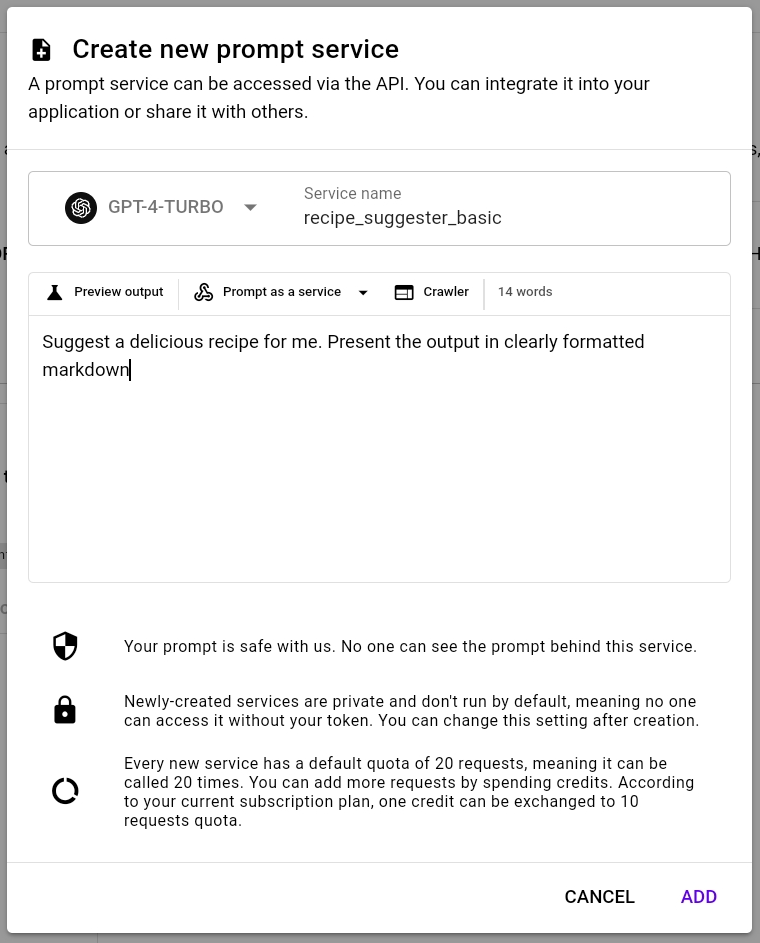
By calling the prompt, a user could get a new recipe each time:
curl "https://api.promptperfect.jina.ai/RYNiqoT3txBjPoALnV46" \
-H "x-api-key: token $YOUR_GENERATED_SECRET" \
-H "content-type: application/json"View output
Certainly! Below is a recipe for a classic Italian dish, Spaghetti Carbonara. This dish is known for its creamy texture and rich flavors, achieved with minimal ingredients. Enjoy!
Spaghetti Carbonara
Ingredients
- 400g spaghetti
- 150g pancetta or guanciale, diced
- 3 large eggs
- 1 cup (100g) freshly grated Parmesan cheese, plus extra for serving
- 2 cloves garlic, peeled and left whole
- 2 tablespoons extra-virgin olive oil
- Salt and freshly ground black pepper
- A small handful of fresh parsley, chopped (optional)
Instructions
Cook the Pasta
- Bring a large pot of salted water to a boil.
- Add the spaghetti and cook according to the package instructions until al dente.
- Reserve 1 cup of pasta water before draining the spaghetti.
Prepare the Sauce
- In a small bowl, whisk together the eggs and grated Parmesan cheese until well combined. Set aside.
Cook the Pancetta
- While the pasta is cooking, heat the olive oil in a large skillet over medium heat.
- Add the pancetta or guanciale and the whole garlic cloves. Cook, stirring frequently, until the meat is crispy and golden, about 5 minutes.
- Remove and discard the garlic cloves.
Combine Pasta and Pancetta
- Add the drained spaghetti to the skillet with the pancetta.
- Toss well to coat the pasta in the pancetta's fat.
Make Carbonara
- Remove the skillet from the heat.
- Quickly pour the egg and cheese mixture into the pasta, stirring vigorously with tongs or a fork until the eggs thicken but do not scramble.
- Add a little reserved pasta water if the sauce is too thick. The heat from the pasta will cook the eggs and melt the cheese to create a creamy sauce.
- Season generously with freshly ground black pepper and add a pinch of salt if needed.
Garnish and Serve
- Serve immediately with extra grated Parmesan cheese and a sprinkle of chopped parsley, if desired.
Enjoy your delicious Spaghetti Carbonara!
This recipe serves 4 people and is best enjoyed fresh.
Template prompts
Now, static prompts are fine and all, but we also allow template prompts. This means a user could set options (like ingredients or dietary restrictions) each time they called the prompt:
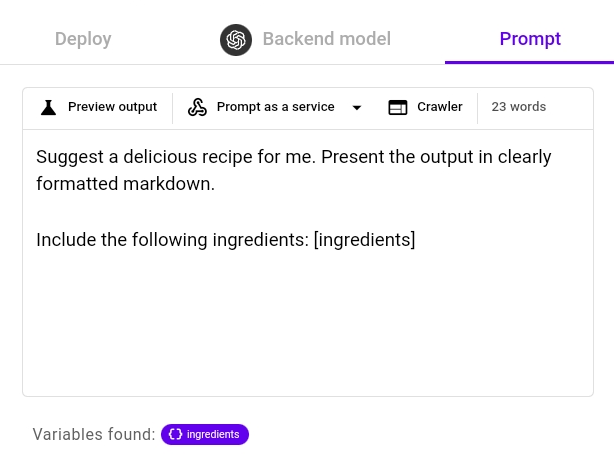
Which would give the user something like:
curl "https://api.promptperfect.jina.ai/RYNiqoT3txBjPoALnV46" \
-H "x-api-key: token $YOUR_GENERATED_SECRET" \
-H "content-type: application/json" \
--data '{"parameters": {"ingredients":"apples, cinnamon, nutmeg"}}'View output
Classic Apple Crisp Recipe
Enjoy the sweet and spicy flavors of apples, cinnamon, and nutmeg in this deliciously easy-to-make apple crisp. Perfect for a cozy night in or a festive gathering!
Ingredients:
- 6 medium-sized apples, peeled, cored, and thinly sliced
- 1 teaspoon ground cinnamon
- 1/4 teaspoon ground nutmeg
- 3/4 cup granulated sugar
- 2 tablespoons lemon juice
For the Topping:
- 3/4 cup all-purpose flour
- 3/4 cup old-fashioned rolled oats
- 1/2 cup light brown sugar, packed
- 1/2 teaspoon baking powder
- 1/4 teaspoon ground cinnamon
- 1/4 teaspoon salt
- 1/3 cup unsalted butter, melted
Instructions:
Preheat Oven and Prepare Apples:
- Preheat your oven to 350°F (175°C).
- In a large mixing bowl, combine the sliced apples with granulated sugar, 1 teaspoon cinnamon, nutmeg, and lemon juice. Toss to coat the apples evenly.
- Transfer the apple mixture to a greased 9-inch square baking dish, spreading them out evenly.
Make the Topping:
- In a separate bowl, mix the flour, oats, brown sugar, baking powder, 1/4 teaspoon cinnamon, and salt.
- Pour the melted butter over the dry ingredients and mix until the mixture is crumbly.
Assemble and Bake:
- Sprinkle the crumbly oat topping evenly over the apples in the baking dish.
- Bake in the preheated oven for about 45 minutes, or until the topping is golden brown and the apples are bubbling around the edges.
Serve:
- Allow the apple crisp to cool slightly before serving.
- Serve warm, optionally with a scoop of vanilla ice cream or a dollop of whipped cream.
Notes:
- Choosing Apples: For the best texture and flavor, use a mix of tart and sweet apples like Granny Smith and Honeycrisp.
- Storage: Leftover apple crisp can be stored in the refrigerator for up to 3 days. Reheat in the oven or microwave before serving.
A time and a place for everything
Now we're taking it up a notch with environmental awareness. Rather than the end-user having to specify where (and when) they are, you can choose to have that information automatically inserted. That means you can create a prompt once, and end-users will get different results depending on their location, date, and time.
Since recipes don’t usually need a specified time and place, let’s consider a new example: Building a website to suggest activities for a user to take part in:
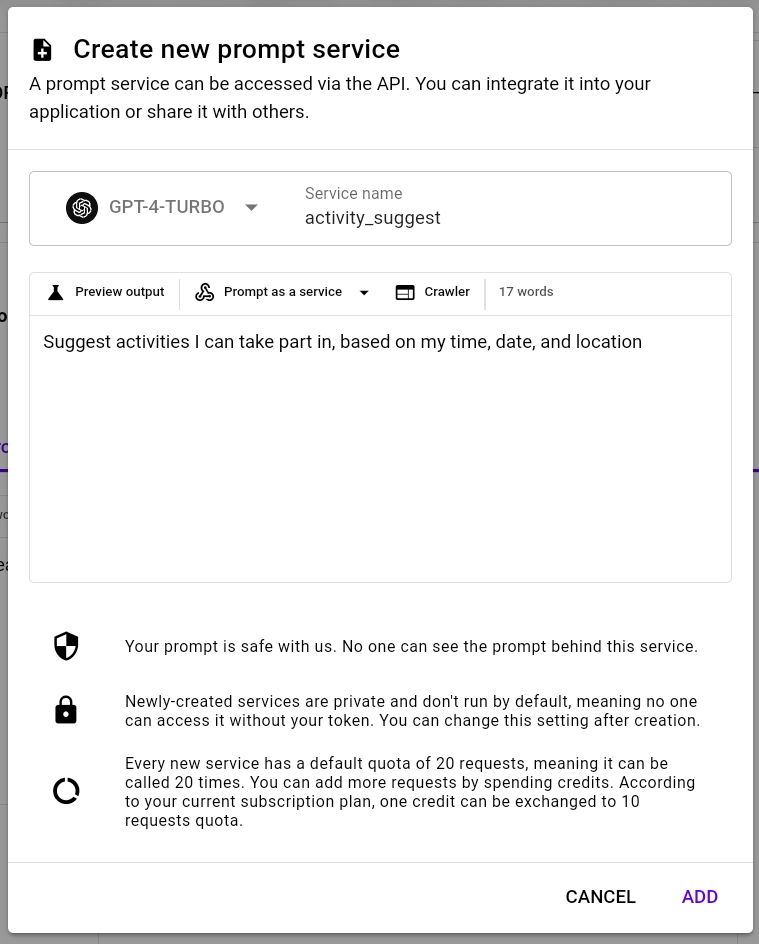
We also need to enable Environment Awareness:

Now, I (in Berlin at noon) get something like this when I call the prompt:
- Visit the Berlin Wall Memorial at Bernauer Straße
- Explore the Museum Island, especially the Pergamon Museum
- Take a walk through the Tiergarten Park
- Enjoy panoramic views from the Berliner Fernsehturm (TV Tower)
- Discover German history at the German Historical Museum
- Stroll along the East Side Gallery
- Check out the Brandenburg Gate at dusk
- Experience contemporary art at the Hamburger Bahnhof museum
- Shop or window-shop at Kurfürstendamm
- Relax in the evening at a traditional German beer garden"
Whereas if my colleague in Tokyo called the prompt, she'd get:
- Visit Tokyo Skytree for panoramic views of the city at night.
- Explore the vibrant streets of Shibuya and see the famous Shibuya Crossing.
- Enjoy the illuminated Tokyo Tower and consider an evening visit.
- Take a stroll through the historic Asakusa district and see Senso-ji Temple.
- Experience the nightlife in Roppongi, known for its clubs and bars.
- Relax at Odaiba Seaside Park and enjoy the night view of Rainbow Bridge.
- Try out some local izakayas (Japanese pubs) for food and drinks.
- Visit a themed café, like a cat café or an owl café, for a unique experience.
- Check out the latest gadgets and tech in Akihabara, the electronics district.
- Attend a traditional Kabuki performance at Kabukiza Theatre in Ginza (if available).
- Indulge in a sushi dinner at one of Tokyo's renowned sushi restaurants.
These variables are great when you're crafting prompts that deliver relevant output based on the user’s time, date, and location. This is ideal for building websites and apps with a global audience.
Fetching remote data
We can go even further though. With the crawler feature, you can download the main body text of the URL you specify:
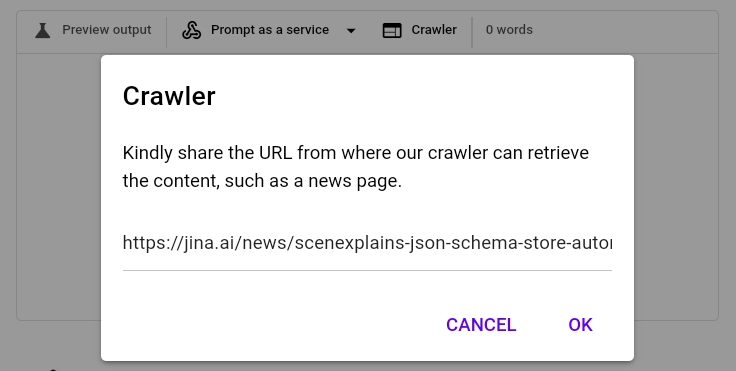
This makes it ideal for, say, a summarizer/translator prompt. Here we summarize an article and convert it to a sea shanty:
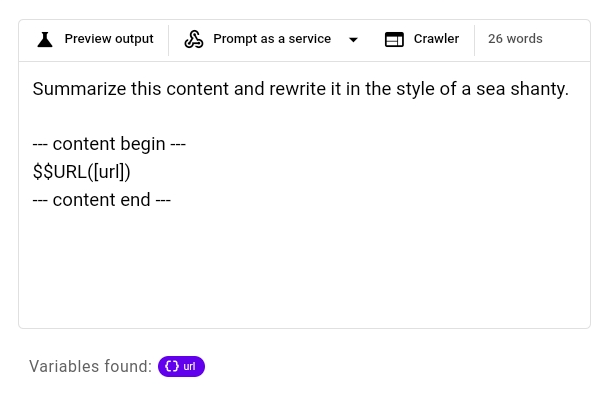
If I pass the URL for this story on Elon Musk's spaceship exploding, I get this (abridged) output:
(Verse 1)
Oh, gather 'round, me hearties, and a tale I'll tell to thee,
Of SpaceX's Starship, and its flight so brief at sea.
Launched on a morn in November, with power so fierce and grand,
She climbed into the heavens, but 'twas not as Musk had planned.
(Chorus)
Heave ho, lift high, to the stars we aim to fly,
But the rocket's dreams did shatter, and into the sea did die.
Heave ho, lift high, with a fiery tail in sky,
SpaceX's Starship faltered, and we're left to wonder why.
(Verse 2)
The booster and the spacecraft, they parted with a roar,
The engines blazed like comets, as they'd never done before.
The booster met its ending, in a ball of flame it fell,
While Starship soared a moment more, then silence cast its spell.
Calling other prompt services
The above example wasn't exactly modular. I had both the summarizer and shantyizer in one prompt. That isn't so useful if I want to shanty all my things in full detail. Luckily, you can also call one prompt from another, allowing for a lot more modularity:
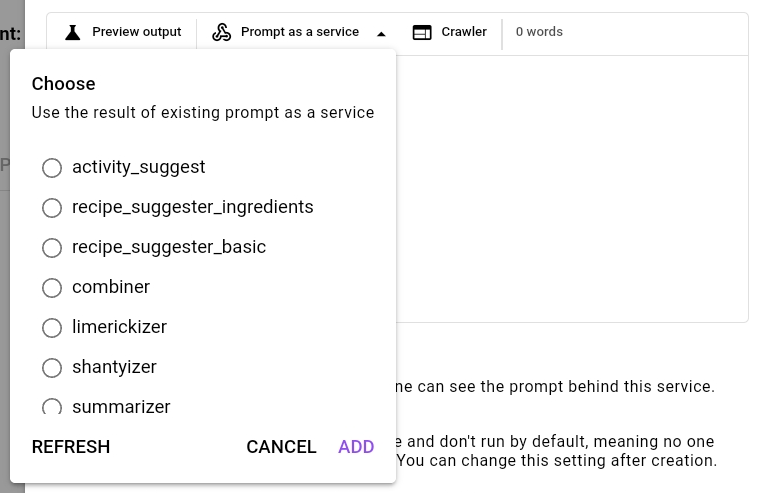
So, if I create a summarizer prompt (named summarizer, which has the sole function of summarizing a web page)…

…I can easily call it from a new shantyizer prompt:
![Markdown editor interface with an instruction to create a shanty, an input labelled "$summarizer([url])", and a note "Variables found: url"](https://jina-ai-gmbh.ghost.io/content/images/2023/12/Screenshot_20231207_125751_Chrome-1.png)
Sending a URL to the shantyizer prompt in turn processes the URL through the summarizer to download and summarize its contents. And of course, the summarizer can be used in any other prompt you like, acting more like a traditional programming language function.
That opens up many more possibilities. Especially when it comes to more complex tasks like cooking a dish. If I’m cooking, for any given recipe I may want one or more of the following steps, but perhaps not all steps for all recipes.
- Download the content of a recipe page
- If it's not in English, translate it (if I'm cooking an authentic Chinese recipe, I want it from a real Chinese website)
- Make it vegetarian (if I'm eating with vegetarian friends)
- Convert it to metric (because reasons)
- Change serving size (depending on how many people I'm eating with)
Exercise for the reader
As you can imagine, if I'm eating alone (and I'm not a vegetarian), my needs are quite different from when I'm eating with my buddies at the local sea kitten appreciation society. Either way, it means combining several of these "functions".
We can also go multi-modal, combining text and image prompts:
- Create an image generation prompt from the given recipe
- Generate an image of how the food should look
The exercise for you, dear reader, is to build a prompt that performs the above recipe steps (or similar). Share your results on our Discord!
Make the magic happen
To get started with magic variables, head to promptperfect.jina.ai and get started. Let us know what you cook up on our Discord!



